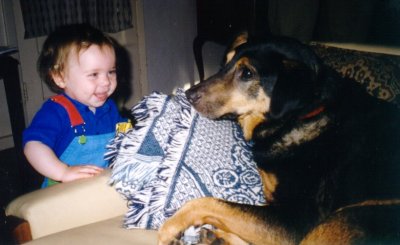Dogs
Today, some sidelights on the history of dogs. The University of Houston's College of Engineering presents this series about the machines that make our civilization run, and the people whose ingenuity created them.
A recent issue of Discovering Archaeology magazine has two articles on dogs. We've long supposed that the symbiosis between human and dog developed as dogs followed Neolithic hunters and scavenged scraps. But animal species don't bond the way human and dog have bonded without there being a balance of benefits. So what was in it for the humans? The common assumption was that animals offered companionship in exchange for food, and that humans accepted the gift. Although that much appears be true, the gift of companionship runs a lot deeper than we realized.
Archaeological evidence now shows that wolf-like animals first evolved in the Americas. They migrated to Europe over the Bering Strait land bridge ten million years ago. Dogs didn't evolve away from wolves until only 130,000 years ago. That makes dogs about as old as the Neanderthals. We modern humans didn't appear until 40,000 years ago, and we've domesticated dogs for only a scant 14,000 years. That's roughly when human burials begin to include the remains of dogs.
Biologist Wolfgang Schleidt describes evidence that humans both profited and learned from wolves and dogs, long before any bonding or domestication took place. Humans following reindeer (and other) herds would hunt the best specimens. That would've led to weakened herds. But canine packs followed the same herds, weeding out the weakest animals. They did humans a service by maintaining the quality of the herds.
More than that, canines taught cooperative hunting to humans. Wolves and dogs are unique among animals for the texture of their cooperation. They don't compete within the pack; they form friendships instead. Apes and monkeys don't do that. An ape bonds to a mate, or to its children, but a dog has friends beyond its kin.
So human and dog joined forces in the hunt, and dogs helped to humanize us (or to doggify us). We find an early stone-age farmer buried with tools for grinding grain and with his favorite dog. A brick from the third-millennium-BC City of Ur is stamped with an inscription. But it has also been marred by four dog footprints left in the once-wet clay. A sixteenth-century crowd scene painted by Pieter Brueghel shows a blind man with a seeing-eye dog.
We've all been led to think that dogs are just one more house pet. It turns out that they're much more. They were part of our process of coming of age. Now we find that bonding with a dog lowers our blood pressure, cholesterol and triglycerides. We suffer less depression. No wonder Elizabeth Barrett wrote these lines when her dog died:
Therefore to this dog will I,
...
Render praise and favor:
With my hand upon his head,
Is my benediction said
Therefore and forever.
I'm John Lienhard, at the University of Houston, where we're interested in the way inventive minds work.
(Theme music)
Schleidt, W. M., Apes, Wolves, and the Trek to Humanity. Discovering Archaeology, Mar/April 1999, pp. 8-10.
Rathje, W. L., Canis familiaris: Going to the Dogs. Discovering Archaeology, March/April 1999, pp. 108-111.
